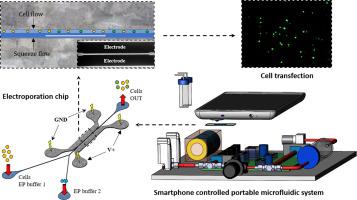当前位置:
X-MOL 学术
›
Bioelectrochemistry
›
论文详情
Our official English website, www.x-mol.net, welcomes your feedback! (Note: you will need to create a separate account there.)
A low-cost smartphone controlled portable system with accurately confined on-chip 3D electrodes for flow-through cell electroporation.
Bioelectrochemistry ( IF 5 ) Pub Date : 2020-02-24 , DOI: 10.1016/j.bioelechem.2020.107486 Chao Han 1 , Xiwen He 2 , Jie Wang 3 , Lingeng Gao 2 , Guang Yang 2 , Dongji Li 2 , Shuying Wang 2 , Xiang Chen 2 , Zhihai Peng 4
Bioelectrochemistry ( IF 5 ) Pub Date : 2020-02-24 , DOI: 10.1016/j.bioelechem.2020.107486 Chao Han 1 , Xiwen He 2 , Jie Wang 3 , Lingeng Gao 2 , Guang Yang 2 , Dongji Li 2 , Shuying Wang 2 , Xiang Chen 2 , Zhihai Peng 4
Affiliation

|
Microscale flow-through electroporation at DC voltage has advantages in delivering small molecules. Yet, electroporation based on constant voltage are liable to generate electrolysis products which limits the voltage-operating window. Parallel on-chip 3D electrodes with close and uniform spacing are required to cut down voltage as well as provide enough electric field for electroporation. Here we present a simple electrode fabrication method based on capillary restriction valves in Z-axis to achieve parallel 3D electrodes with controllable electrode spacing in PDMS chips. With electrodes accurately placed in close range, a low voltage of only 1.5 V can generate enough electric field (>400 V/cm) to make cell membrane permeable. Squeeze flow is introduced to produce higher electric field (>800 V/cm) at a fixed voltage for more efficient electroporation. Benefit from the electrode fabrication method and application of squeeze flow, we develop a smartphone controlled microfluidic electroporation system which integrate functions of sample injection, pressure regulating, real-time observation and constant DC power supply. The system is used to electroporate two cell lines, showing a permeabilization percentage of 63% for HEK-293 cells and 58% for CHO-K1 cells with optimal parameters. Thus, the portable microfluidic system provides a cost-effective and user-friendly flow-through cell electroporation platform.
中文翻译:

低成本智能手机控制的便携式系统,带有精确限定的芯片上3D电极,用于流通式细胞电穿孔。
直流电压下的微型流通式电穿孔在递送小分子方面具有优势。然而,基于恒定电压的电穿孔易于产生限制电压操作窗口的电解产物。需要具有紧密且均匀间隔的并行芯片上3D电极以降低电压并为电穿孔提供足够的电场。在这里,我们介绍了一种基于Z轴上的毛细管限制阀的简单电极制造方法,以在PDMS芯片中实现具有可控电极间距的平行3D电极。通过将电极精确地放置在近距离范围内,仅1.5 V的低压即可产生足够的电场(> 400 V / cm),从而使细胞膜可渗透。引入挤压流以产生更高的电场(> 800 V / cm)在固定电压下进行更有效的电穿孔。得益于电极的制造方法和挤压流的应用,我们开发了一种智能手机控制的微流控电穿孔系统,该系统集成了样品注入,压力调节,实时观察和恒定直流电源等功能。该系统用于电穿孔两个细胞系,显示具有最佳参数的HEK-293细胞的透化百分比为63%,CHO-K1细胞的透化百分比为58%。因此,便携式微流体系统提供了一种经济高效且用户友好的流通式细胞电穿孔平台。实时观察和恒定直流电源。该系统用于电穿孔两个细胞系,显示具有最佳参数的HEK-293细胞的透化百分比为63%,CHO-K1细胞的透化百分比为58%。因此,便携式微流体系统提供了一种经济高效且用户友好的流通式细胞电穿孔平台。实时观察和恒定直流电源。该系统用于电穿孔两个细胞系,显示具有最佳参数的HEK-293细胞的透化百分比为63%,CHO-K1细胞的透化百分比为58%。因此,便携式微流体系统提供了一种经济高效且用户友好的流通式细胞电穿孔平台。
更新日期:2020-02-24
中文翻译:

低成本智能手机控制的便携式系统,带有精确限定的芯片上3D电极,用于流通式细胞电穿孔。
直流电压下的微型流通式电穿孔在递送小分子方面具有优势。然而,基于恒定电压的电穿孔易于产生限制电压操作窗口的电解产物。需要具有紧密且均匀间隔的并行芯片上3D电极以降低电压并为电穿孔提供足够的电场。在这里,我们介绍了一种基于Z轴上的毛细管限制阀的简单电极制造方法,以在PDMS芯片中实现具有可控电极间距的平行3D电极。通过将电极精确地放置在近距离范围内,仅1.5 V的低压即可产生足够的电场(> 400 V / cm),从而使细胞膜可渗透。引入挤压流以产生更高的电场(> 800 V / cm)在固定电压下进行更有效的电穿孔。得益于电极的制造方法和挤压流的应用,我们开发了一种智能手机控制的微流控电穿孔系统,该系统集成了样品注入,压力调节,实时观察和恒定直流电源等功能。该系统用于电穿孔两个细胞系,显示具有最佳参数的HEK-293细胞的透化百分比为63%,CHO-K1细胞的透化百分比为58%。因此,便携式微流体系统提供了一种经济高效且用户友好的流通式细胞电穿孔平台。实时观察和恒定直流电源。该系统用于电穿孔两个细胞系,显示具有最佳参数的HEK-293细胞的透化百分比为63%,CHO-K1细胞的透化百分比为58%。因此,便携式微流体系统提供了一种经济高效且用户友好的流通式细胞电穿孔平台。实时观察和恒定直流电源。该系统用于电穿孔两个细胞系,显示具有最佳参数的HEK-293细胞的透化百分比为63%,CHO-K1细胞的透化百分比为58%。因此,便携式微流体系统提供了一种经济高效且用户友好的流通式细胞电穿孔平台。



























 京公网安备 11010802027423号
京公网安备 11010802027423号